
Chondrichthyes is a class of jawed fish that contains the cartilaginous fish or chondrichthyans, which all have skeletons primarily composed of cartilage. They can be contrasted with the Osteichthyes or bony fish, which have skeletons primarily composed of bone tissue. Chondrichthyes are aquatic vertebrates with paired fins, paired nares, placoid scales, conus arteriosus in the heart, and a lack of opercula and swim bladders. Within the infraphylum Gnathostomata, cartilaginous fishes are distinct from all other jawed vertebrates.

Acanthodii or acanthodians is an extinct class of gnathostomes. They are currently considered to represent a paraphyletic grade of various fish lineages basal to extant Chondrichthyes, which includes living sharks, rays, and chimaeras. Acanthodians possess a mosaic of features shared with both osteichthyans and chondrichthyans. In general body shape, they were similar to modern sharks, but their epidermis was covered with tiny rhomboid platelets like the scales of holosteians.
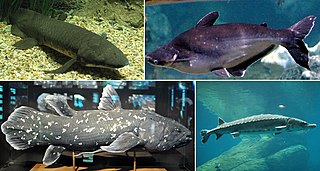
Teleostomi is an obsolete taxon of jawed vertebrates that supposedly includes the tetrapods, bony fish, and the wholly extinct acanthodian fish. Key characters of this group include an operculum and a single pair of respiratory openings, features which were lost or modified in some later representatives. The teleostomes include all jawed vertebrates except the chondrichthyans and the extinct class Placodermi.
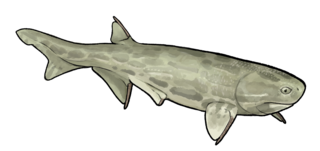
Acanthodes is an extinct genus of acanthodian fish. Species have been found in Europe, North America, and Asia, spanning the Early Carboniferous to the Early Permian, making it one of the youngest known acanthodian genera.

Mesacanthus is an extinct genus of acanthodian fish from Devonian Scotland. It is among the more primitive of the Devonian acanthodians.

Cheiracanthus is an extinct genus of a group of fish called Acanthodii. It was a deep-bodied acanthodian about 12 in. (30 cm) in length. It had a blunt head, upturned tail, and fins protected by spines. Unlike many other acanthodians, it had one, solitary dorsal fin. Cheiracanthus swam at mid-depth in lakes and rivers, seizing small prey in its gaping jaws. Whole fossils of this fish occur only in Mid-Devonian rocks in Scotland, but its distinctive small, ornamented scales crop up around the world, as far south as Antarctica.
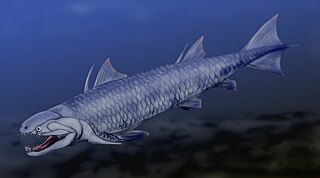
Psarolepis is a genus of extinct bony fish which lived around 397 to 418 million years ago. Fossils of Psarolepis have been found mainly in South China and described by paleontologist Xiaobo Yu in 1998. It is not known certainly in which group Psarolepis belongs, but paleontologists agree that it probably is a basal genus and seems to be close to the common ancestor of lobe-finned and ray-finned fishes. In 2001, paleontologist John A. Long compared Psarolepis with onychodontiform fishes and refer to their relationships.

Parexus is an extinct genus of acanthodian fish. Acanthodians are often referred to as ‘spiny sharks’, although acanthodians are not true sharks and evolved perhaps 50 million years earlier than sharks. Acanthodians share several features with bony fish and cartilaginous fish; they often have spines supporting their fins.

Ischnacanthus is an extinct genus of acanthodian jawed fish. It lived from the Pridoli to the Lochkovian. The type species I. gracilis is only known from Lochkovian.
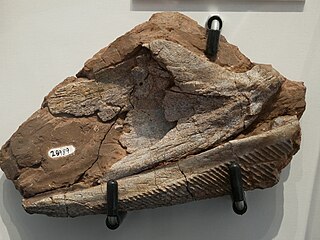
Gyracanthus is an extinct genus of acanthodian.

Nerepisacanthus is an extinct genus of acanthodian, probably acritolepid, from Middle Silurian deposits of New Brunswick, Canada. Nerepisacanthus is known from many incomplete but articulated specimens. It was collected from the Cunningham Creek Formation, near Nerepis, southern New Brunswick. It was first named by Carole J. Burrow in 2011 and the type species is Nerepisacanthus denisoni. Additional specimen is known from Bertie Formation, making that species the oldest near-complete acanthodian.
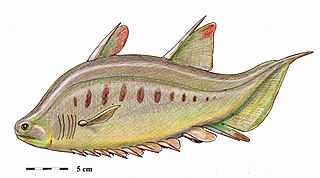
Brochoadmones is an extinct genus of acanthodian from the Devonian of what is now Canada. It is the only genus in the suborder Brochoadmonoidei, whose relationship to other acanthodian orders remains currently in flux.

Tetanopsyrus is a genus of Acanthodii. There are two species of this genus that lived through the lower Devonian (Lochkovian), some 416 to 359 million years ago.

Gyracanthides is an extinct genus of acanthodian gnathostome, known from Devonian to Early Carboniferous.

Ptomacanthus is an extinct genus of spiny shark, an early relative of living cartilaginous fishes.

Websteroprion is a genus of eunicidan polychaete that lived during the middle Devonian period in what is now Canada. It contains a single species, W. armstrongi, recovered from the Kwataboahegan Formation.

Acanthodiformes is an order of acanthodian fishes which lived from the Early Devonian to Early Permian.
Xylacanthus is a genus of extinct acanthodian fish belonging to the family Ischnacanthidae. It lived during the Silurian to Devonian periods. Three species of Xylacanthus are known, X. kenstewarti from Late Wenlock to Early Ludlow from the Mackenzie Mountains in Canada, X. minutus from Lochkovian of Spitsbergen in Norway, and X. grandis from Siegenian of Spitsbergen. X. grandis was the largest acanthodian with 35 cm (14 in) long jaw bone and estimated total length of 2.5 m.
Acanthodopsis is a genus of Acanthodian fish from the family Acanthodidae. It lived during the Carboniferous period. Acanthodopsis fossils have been discovered in Australia and England. The largest species could have reached up to 75 cm in length while others were much smaller.























